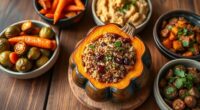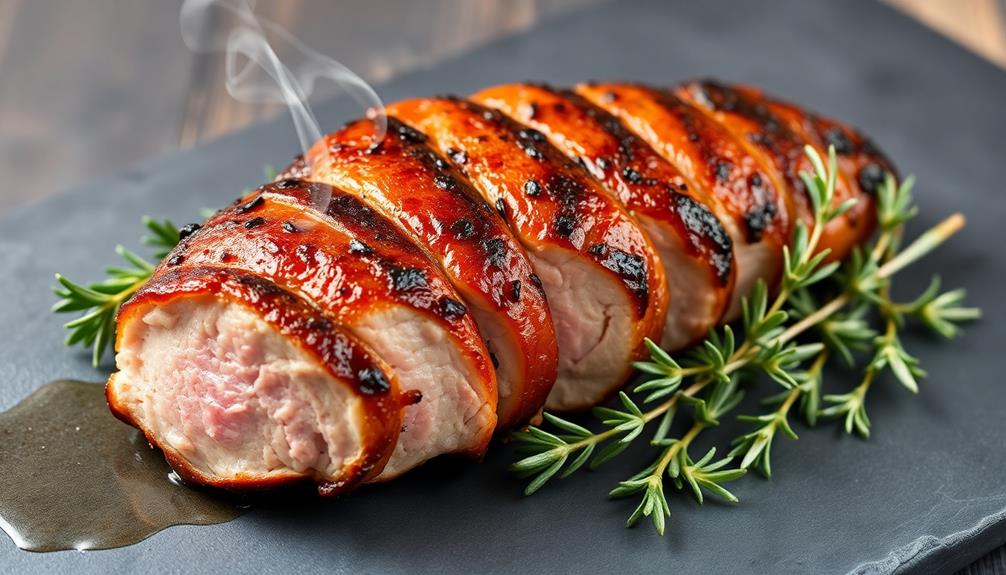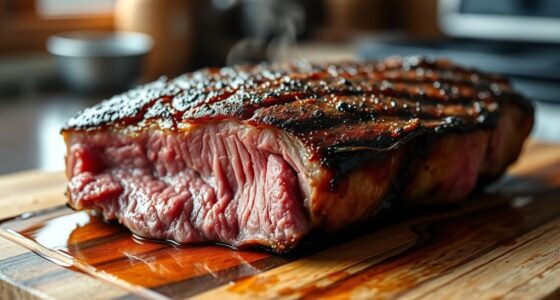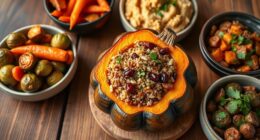Understanding baking temperatures and conversions is key to successful baking. Your oven might not always match the set temperature, so testing with an oven thermometer helps you calibrate it precisely. Knowing how to adjust recipes for different temperatures and rack positions ensures even baking and the right texture. Regularly checking and fine-tuning your oven builds confidence in your results. Keep exploring to learn more tips that can improve your baking every time.
Key Takeaways
- Familiarize yourself with common baking temperature ranges (e.g., 325°F to 425°F) for different recipes.
- Use an oven thermometer to accurately measure and calibrate your oven’s temperature.
- Understand temperature conversions between Fahrenheit and Celsius for versatile baking.
- Adjust oven settings or calibration if your oven’s actual temperature differs from the set temperature.
- Follow recipe-specific temperature guidelines and rack positioning for optimal baking results.
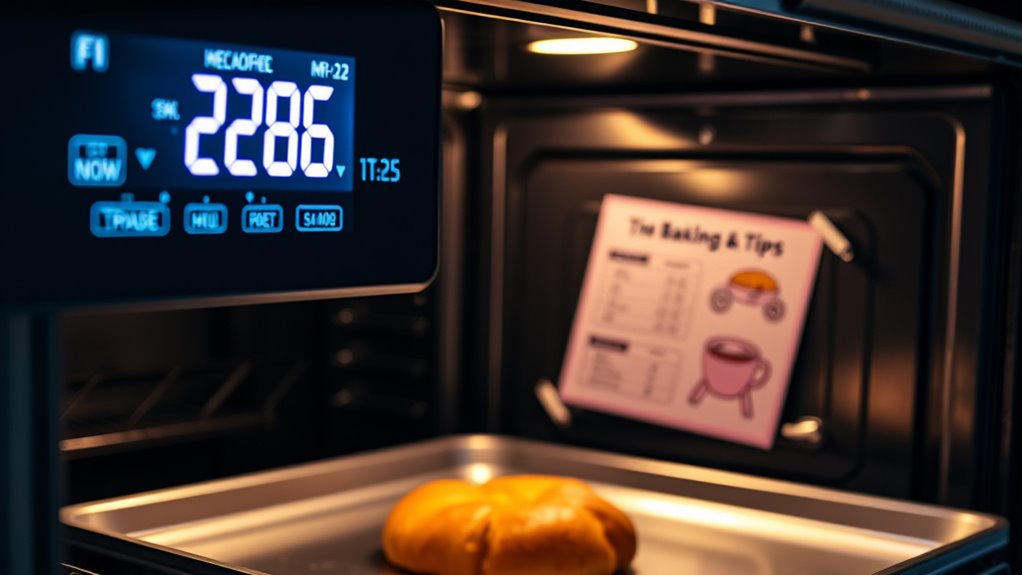
Ovens are vital appliances in any kitchen, helping you cook everything from simple snacks to elaborate meals. To get the best results, understanding baking temperature tips is essential. The right temperature ensures your baked goods cook evenly, develop the perfect texture, and look appealing. One of the first steps is mastering oven calibration techniques. Over time, ovens can lose accuracy, causing your recipes to turn out either undercooked or burnt. To check your oven’s calibration, you can place an oven thermometer inside and set your oven to the desired temperature. If the thermometer shows a different reading, it’s time to adjust your oven’s temperature dial accordingly. Many modern ovens have calibration options to fine-tune this, but if yours doesn’t, you might need to consult the manufacturer or a professional appliance technician. Proper calibration is the foundation for consistent baking results. Regular testing and calibration can also help ensure your oven maintains the right temperature over time, which is crucial for reliable baking outcomes.
Knowing your oven’s true temperature allows you to follow baking temperature tips more effectively. For example, many recipes specify a range like 350°F to 375°F, but if your oven runs hot or cool, you’ll need to adapt. When baking cookies or delicate pastries, a precise temperature can make the difference between perfectly crisp edges and soggy bottoms. For bread, consistent heat helps develop a good rise and crust. To guarantee accuracy, use an oven thermometer regularly and recalibrate as needed. Keep in mind that opening the oven door frequently can cause temperature fluctuations, so try to minimize door openings during baking. Also, always preheat your oven fully before placing your baked goods inside to guarantee the temperature stabilizes. Understanding oven calibration techniques and applying proper baking temperature tips will help you achieve consistent, high-quality results every time.
Baking temperature tips also include understanding how different racks affect heat exposure. Higher racks tend to be warmer, which is useful for browning or finishing dishes, while lower racks are better for slow, even baking. If your recipes specify a particular rack position, follow that to achieve the best results. Additionally, adjusting your oven’s temperature slightly, based on your calibration findings, can improve outcomes. For instance, if your oven runs 15°F low, increasing the setting slightly will help you hit the target temperature more accurately. Remember, oven calibration techniques aren’t complicated but can greatly impact your baking success. Regularly testing and adjusting your oven helps you become more confident in your cooking, making sure your baked goods turn out just right every time.
Frequently Asked Questions
How Do Altitude Changes Affect Baking Temperatures?
When baking at altitude, you need to make altitude adjustments to your recipes because higher elevations cause lower air pressure. This affects how baked goods rise and cook. To compensate, increase oven temperatures slightly, usually by 15-25°F, and adjust ingredients like reducing sugar or increasing liquid. These altitude adjustments guarantee your baked goods turn out perfectly, so pay attention to recipe modifications when baking at altitude.
Can I Convert Celsius to Fahrenheit Accurately for Baking?
You can convert Celsius to Fahrenheit accurately, but you need to follow the right formula: multiply Celsius by 1.8 and add 32. That’s the best way to guarantee measurement accuracy. Don’t leave it to guesswork, or you’ll be chasing your tail in the kitchen. Using a reliable calculator or conversion chart helps you get it right every time, so your baked goods turn out perfect—no room for error.
What Causes Temperature Fluctuations in My Oven?
You experience temperature fluctuations because your oven has hot spots and uneven heating. These hot spots cause some areas to be hotter than others, affecting your baking time and results. Over time, oven thermostats can also drift, leading to inconsistent temperatures. Regularly rotating your baked goods and using an oven thermometer helps identify hot spots and guarantee more even baking, reducing the impact of temperature fluctuations on your baked items.
How Do I Calibrate My Oven’s Temperature Settings?
To calibrate your oven for better temperature accuracy, start by placing an oven thermometer inside. Turn the oven on to your desired temperature, then compare the reading. If it’s off, consult your oven’s manual for calibration instructions—often, you can adjust the temperature dial or control panel. Regular oven calibration guarantees consistent baking results, helping you avoid under- or overcooked treats and maintain precise temperature accuracy.
Are There Specific Temperature Guidelines for Gluten-Free Baking?
Think of gluten-free baking temperature guidelines like a delicate dance—you need just the right steps. When baking with gluten-free flour, you should slightly lower your baking temperature by about 25°F to prevent over-browning. Most recipes call for a standard oven temperature of 350°F; for gluten-free, aim for around 325°F. Keep an eye on your baked goods, as gluten-free items can brown faster without gluten’s structure.
Conclusion
Now that you know how to master baking temperatures and conversions, you’ll confidently tackle any recipe. Did you know that over 60% of home bakers accidentally underbake their treats because of temperature confusion? Don’t let that be you! With these tips, you’ll get perfect results every time. Keep experimenting and adjusting, and soon baking will feel like second nature. Happy baking!

